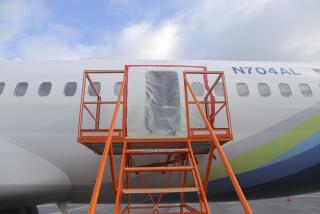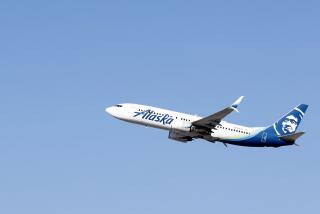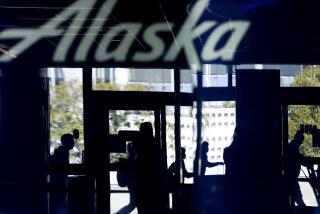Tapes Point to Engine Problems in Denver Plane Crash
- Share via
Cockpit recordings confirm that a jetliner that crashed on takeoff in Denver apparently suffered engine problems that could have resulted in significant loss of power in the seconds before the plane slammed into the ground, federal officials said Thursday.
The National Transportation Safety Board, which is investigating the Nov. 15 crash of the Continental Airlines DC-9, said that tapes from the “black box” cockpit voice recorder picked up four distinct sounds “similar to an engine compression stall.”
The runways at Denver’s Stapleton International Airport were wet and slushy when the plane made its unsuccessful attempt to take off during a snowstorm, and aviation experts have noted that DC-9s are especially vulnerable to compression stalls under such conditions.
Cause Still Undetermined
However, NTSB officials stressed Thursday that it is still too early to say whether compression stall--or any other form of engine failure--caused Flight 1713, bound for Boise, Ida., to crash as it lifted off, killing 28 of the 82 people aboard, including both pilots.
Attention in the investigation has been focused on three possible factors:
--Engine problems.
--The relative inexperience of the crew.
--The possibility that ice accumulating while the plane waited for takeoff could have added extra weight to the DC-9 and altered the shape of its wings so that they did not provide adequate lift.
The voice recorder transcript released in Washington on Thursday by the NTSB confirmed early speculation that the co-pilot--Lee Edward Brucher, 26, of Houston, who had 3,150 hours total flight experience but just 36 1/2 hours of it in a DC-9--was at the controls when the plane attempted the takeoff from Stapleton’s Runway 35 Left.
In addition, the transcript confirmed previous reports that the plane, while it was de-iced after leaving the departure gate, waited 23 minutes before receiving clearance for takeoff.
No Signs of Danger
Neither Brucher nor the pilot in command of the flight--Frank Zvonek, 43, of Carlsbad, Calif., who had more than 12,000 hours total flight time but just 33 hours of it as captain of a DC-9--indicated any concern about possible trouble in the moments leading up to the crash, according to the transcript.
In fact, the 32-minute recording indicates that Brucher and Zvonek engaged in light banter during their 23-minute wait in the snowstorm, lapsing occasionally into gentle ribaldry as they killed time while running through their pre-flight checklists. Then, at 57 seconds after 2:12 p.m.--about 29 minutes after the recording began--another Continental plane, Flight 875, could be heard telling controllers about “a little clutter on the runway.”
Fourteen seconds later, the control tower relayed a general report of “a little crud on the runway,” adding, “I don’t know how to define that.”
“A little crud . . . “ Brucher mimicked, adding a few seconds later, “I got it over here, too.”
“Don’t slide,” Zvonek said, adding about 30 seconds later, “got the brakes on; you got the plane.”
Cleared for Takeoff
At 2:12:31, controllers cleared Flight 1713 for takeoff. Zvonek acknowledged the clearance, and 13 seconds later, the engines could be heard revving up as the DC-9 began accelerating down the runway.
“There’s 100 knots,” Zvonek reported as the plane’s speed topped 115 m.p.h.
“Rotate,” the captain said about 13 seconds later, ordering Brucher to pull back on the control yoke.
“Positive rate,” Zvonek added about 5 1/2 seconds after that, indicating that the big plane had begun to lift off the runway.
Up to that point, there was no indication on the transcript that anything was wrong.
Then, suddenly, 3 seconds later, there was the first sound, like a compressor stall.
Brucher shouted an expletive (deleted by NTSB censors).
Over the next five seconds, there was another stall sound, a bang, and two more stall sounds.
Then, at 2:14:43, there was a final sound of impact.
The twisting, tumbling fuselage had slammed into the ground, scattering debris for more than 1,500 feet along a shallow gully before coming to rest in the freshly fallen snow.
Cites ‘Engine Surging’
Five days after the crash, NTSB Chairman Jim Burnett first disclosed that investigators listening to the cockpit voice recorder believed that they heard the sounds of compression stalls, or “engine surging.”
While Burnett described such stalls as a sort of “burp,” Wally Roberts, a veteran airline pilot who has flown the DC-9, used stronger terms.
“A compression stall causes a momentary loss or drop in power,” Roberts said. “There can be a significant loss of power for several seconds.”
Noting the wet and slushy runway conditions at Stapleton at the time of the crash, Roberts said that “there’s a real problem with wet runways with a DC-9.”
Roberts said that because of the way the plane is designed, with its twin engines mounted aft and low, beneath the tail, they can suck in water thrown up by the nose wheel.
Possible Ice Peril
In addition, the manufacturer has advised that ice from the wings of a DC-9 can break off during takeoff and tumble back into the engines.
Burnett has said that compression stalls result when the normal airflow into the engines is interrupted--for example, by the ingestion of “foreign” matter like water and ice.
But Burnett has also pointed out that compression stalls can also occur when some other problem forces a plane into an unusual pitch, thus disturbing the air flow into the engines. He also noted that any stalls might have occurred after the plane was already in trouble, headed for the ground.
More to Read
Sign up for Essential California
The most important California stories and recommendations in your inbox every morning.
You may occasionally receive promotional content from the Los Angeles Times.










